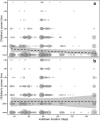Young children's screen time during the first COVID-19 lockdown in 12 countries
- PMID: 35132065
- PMCID: PMC8821703
- DOI: 10.1038/s41598-022-05840-5
Young children's screen time during the first COVID-19 lockdown in 12 countries
Abstract
Older children with online schooling requirements, unsurprisingly, were reported to have increased screen time during the first COVID-19 lockdown in many countries. Here, we ask whether younger children with no similar online schooling requirements also had increased screen time during lockdown. We examined children's screen time during the first COVID-19 lockdown in a large cohort (n = 2209) of 8-to-36-month-olds sampled from 15 labs across 12 countries. Caregivers reported that toddlers with no online schooling requirements were exposed to more screen time during lockdown than before lockdown. While this was exacerbated for countries with longer lockdowns, there was no evidence that the increase in screen time during lockdown was associated with socio-demographic variables, such as child age and socio-economic status (SES). However, screen time during lockdown was negatively associated with SES and positively associated with child age, caregiver screen time, and attitudes towards children's screen time. The results highlight the impact of the COVID-19 lockdown on young children's screen time.
© 2022. The Author(s).
Conflict of interest statement
The authors declare no competing interests.
Figures






Similar articles
-
Impact of the COVID-19 lockdown on the oral health behaviour of young children.Int J Dent Hyg. 2024 Nov;22(4):933-938. doi: 10.1111/idh.12808. Epub 2024 Apr 24. Int J Dent Hyg. 2024. PMID: 38659332
-
Modeling the effect of lockdown timing as a COVID-19 control measure in countries with differing social contacts.Sci Rep. 2021 Feb 8;11(1):3354. doi: 10.1038/s41598-021-82873-2. Sci Rep. 2021. PMID: 33558571 Free PMC article.
-
COVID-19 school and kindergarten closure relates to children's social relationships: a longitudinal study in Japan.Sci Rep. 2022 Jan 24;12(1):814. doi: 10.1038/s41598-022-04944-2. Sci Rep. 2022. PMID: 35075129 Free PMC article.
-
Impact of COVID-19 and lockdown on mental health of children and adolescents: A narrative review with recommendations.Psychiatry Res. 2020 Nov;293:113429. doi: 10.1016/j.psychres.2020.113429. Epub 2020 Aug 24. Psychiatry Res. 2020. PMID: 32882598 Free PMC article. Review.
-
The Association Between Environmental and Social Factors and Myopia: A Review of Evidence From COVID-19 Pandemic.Front Public Health. 2022 Jun 29;10:918182. doi: 10.3389/fpubh.2022.918182. eCollection 2022. Front Public Health. 2022. PMID: 35844861 Free PMC article. Review.
Cited by
-
More frequent naps are associated with lower cognitive development in a cohort of 8-38-month-old children, during the Covid-19 pandemic.JCPP Adv. 2023 Jul 27;3(4):e12190. doi: 10.1002/jcv2.12190. eCollection 2023 Dec. JCPP Adv. 2023. PMID: 38054058 Free PMC article.
-
On What Tasks Did Children between the Ages of 3 and 12 Years Spend Their Time during the COVID-19 Pandemic? An International Comparative Study between Ibero-America and Europe.Children (Basel). 2022 Jun 29;9(7):971. doi: 10.3390/children9070971. Children (Basel). 2022. PMID: 35883955 Free PMC article.
-
Can mindfulness play a role in building social-emotional capacities among youth exposed to screens?Front Psychiatry. 2023 Jun 22;14:1165217. doi: 10.3389/fpsyt.2023.1165217. eCollection 2023. Front Psychiatry. 2023. PMID: 37426093 Free PMC article.
-
Risk of Obesity Among Children Aged 2-6 Years Who Had Prolonged Screen Time in Taiwan: A Nationwide Cross-Sectional Study.Clin Epidemiol. 2023 Feb 13;15:165-176. doi: 10.2147/CLEP.S382956. eCollection 2023. Clin Epidemiol. 2023. PMID: 36817560 Free PMC article.
-
Parental executive functions and motivations unveil variations in young children's screen media use.Psicol Reflex Crit. 2024 Jun 7;37(1):20. doi: 10.1186/s41155-024-00289-z. Psicol Reflex Crit. 2024. PMID: 38847965 Free PMC article.
References
-
- Moore SA, Faulkner G, Rhodes RE, Brussoni M, Chulak-Bozzer T, Ferguson LJ, Raktim Mitra R, O’Reilly N, Spence JC, Vanderloo LM, Tremblay MS. Impact of the COVID-19 virus outbreak on movement and play behaviours of Canadian children and youth: a national survey. Int. J. Behav. Nutr. Phys. Act. 2020;17(1):85. doi: 10.1186/s12966-020-00987-8. - DOI - PMC - PubMed
-
- Chambonniere C, Lambert C, Fearnbach N, Tardieu M, Fillon A, Genin P, Larras B, Melsens P, Bois J, Pereira B, Tremblay A, Thivel D, Duclos M. Effect of the COVID-19 lockdown on physical activity and sedentary behaviors in French children and adolescents: new results from the ONAPS national survey. Eur. J. Integr. Med. 2021;43:101308. doi: 10.1016/j.eujim.2021.101308. - DOI - PMC - PubMed
-
- Schmidt S, Anedda B, Burchartz A, Eichsteller A, Kolb S, Nigg C, Niessner C, Oriwol D, Worth A, Woll A. Physical activity and screen time of children and adolescents before and during the COVID-19 lockdown in Germany: a natural experiment. Sci. Rep. 2020;10(1):21780. doi: 10.1038/s41598-020-78438-4. - DOI - PMC - PubMed
-
- Pietrobelli A, Pecoraro L, Ferruzzi A, Heo M, Faith M, Zoller T, Antoniazzi F, Piacentini G, Fearnbach SN, Heymsfield SB. Effects of COVID-19 lockdown on lifestyle behaviors in children with obesity living in Verona, Italy: a longitudinal study. Obesity. 2020;28(8):1382–1385. doi: 10.1002/oby.22861. - DOI - PMC - PubMed
Publication types
MeSH terms
Grants and funding
LinkOut - more resources
Full Text Sources
Medical

